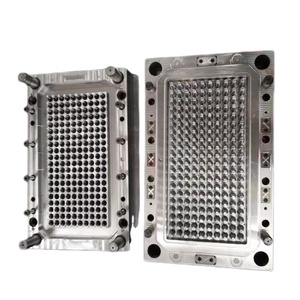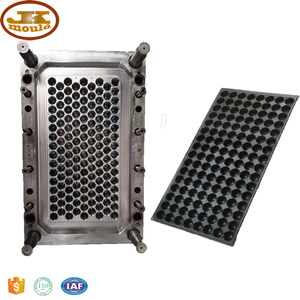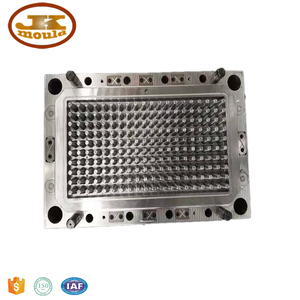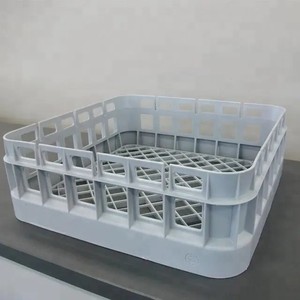
All categories
Featured selections
Trade Assurance
Buyer Central
Help Center
Get the app
Become a supplier

(3647 products available)








































Plastic injection tray moulds are fabricated using variegated materials. Below is a list of some of the materials:
Steel
Usually, steel is the most extensively used material for plastic injection tray moulds due to its resilience and longevity. Additionally, it can withstand the pressure of the injection process and is well able to endure wear and tear over time. Moreover, high-quality steel grades such as D2, S7, and H13 are common for manufacturing moulds.
Aluminum
Aluminum comes in lightweight and less dense than steel. It makes it easier to work with when producing complex mould designs. In addition, it is also a better thermal conductor. Hence, it allows for a more even and quicker heating and cooling process during injection. Normally, aluminum is prized for its cost-effectiveness and efficiency in making short-run production moulds.
Bronze and Brass
Often, bronze and brass are used in making plastic injection moulds because of their superb corrosion retardance properties. In addition, they have outstanding thermal conductivity which aids in lowering the mould temperature during the injection process. This significantly enhances the quality of the product. Ideally, these materials are commonly used in moulds for high-temperature plastics.
Invar
Normally, Invar is a special alloy comprising nickel and iron. This material is popular for its minimal thermal expansion properties. Also, it makes an appealing choice for precision moulds in declination to maintaining tight tolerances amid temperature variations. Usually, Invar moulds are ideal for applications that require high accuracy and consistency in product dimensions.
H13 Steel
H13 steel is a hot-worked steel alloy which is well known for its versatility. Moreover, it offers exceptional toughness, fatigue resistance, and retards wear. It makes it suitable for high-volume production. In addition, this material is commonly used in moulds where large quantities of plastic materials with elevated temperatures are required.
Synthetic Materials
Usually, synthetic materials such as P20 steel and brass are gaining traction in popularity because of their affordability and ease of machining. Also, P20 is a pre-hardened alloy that comes with a superfine balance of durability and toughness. Therefore, it is suitable for low to moderate production volumes. Moreover, these materials are appropriate for applications where cost is of paramount importance.
Plastic injection tray moulds are utilized in disparate applications. Here is a list of the applications:
Food Service Industry
Plastic injection trays are largely used in the food service industry as they provide safe and efficient delivery of food and beverages. In addition, these trays are preferred for packaging, storing, and transporting meals, utensils, and dishes. This guarantees they are specified for heavy use. Also, they come with compartments that are delineated to keep orders organized and prevent spillages.
Medical and Pharmaceutical Packaging
Usually, in the medical and pharmaceutical realms, injection-moulded trays are ideal for segregating and packaging medical instruments, supplies, and medications. Often, these trays come with the ability to be sterilized and manufactured with unadulterated plastics. Therefore, they ensure safety and hygiene. Also, they are utilized in packaging products in a manner that abates contamination and is able to maintain the integrity of the products.
Electronics and Retail Packaging
Commonly, these trays offer protection and display for electronic items and retail products. Additionally, they are designed with a specific focus on absorbing shocks as well as on accommodating various sizes and shapes of items. This allows them to be used for packaging electronics. It helps in preventing damage during transportation and storage and comes with visual appeal that promotes product sales.
Automotive Parts Organization
Plastic injection trays are normally used in the automotive sector for storing and organizing disparate components as well as parts. Additionally, these trays are manufactured with durability enabling them to carry heavy as well as some intricate items. This makes them an indispensable tool for inventory management in assembly lines.
Manufacturing and Assembly Processes
Usually, plastic injection trays play a critical role in production and assembly lines. These trays aid in the transportation of parts and tools. This includes offering efficiency and organization concurrently. Also, they mitigate wastage and enhance productivity by providing a systematic approach to managing these items.
Sports and Outdoor Equipment
These moulds are used to create compartments or organizers in outdoor and sports gear. These include coolers, backpacks, and even camping dishes. Usually, these trays are lightweight and tough, making them an ideal fit for outdoor applications where gear is exposed to harsh conditions.
Several factors contribute to the durability of plastic injection tray moulds. Here is a concise list of those factors:
Mould Material
Usually, the durability of plastic injection tray moulds is mainly influenced by the material from which they are fabricated. Normally, high-quality steel alloys such as H13 and S136 offer exceptional hardness and retards wear. This makes them ideal for long-term use. Also, pre-hardened materials like P20 are common in short production runs.
Design Complexity
Usually, moulds with intricate designs or fine details are more prone to wear and tear, therefore reducing their lifespan. Also, complex geometries can create areas of stress in the mould material which results in cracks or degradation over time. In addition, simpler designs are less subjected to this phenomenon and usually offer improved durability.
Cooling System
Customarily, a well-designed cooling system is critical for maintaining the temperature constancy of the mould during injection. This reduces thermal expansion and contraction that can lead to material fatigue. In addition, inadequate cooling may cause overheating in certain areas resulting in faster wear. Thus, it impacts mould durability.
Maintenance and Care
Typically, regular maintenance has a significant impact on mould durability. In addition, activities such as cleaning, lubrication, and inspection assist in identifying wear early enough as well as in preventing rust. Also, proper care helps maintain the mould’s structural integrity in the long run. Therefore, it can extend its lifespan considerably.
Injection Pressure
Usually, high injection pressure can cause excessive stress on the mould. This leads to faster wear. Often, maintaining appropriate pressure levels is important for preserving the durability of the mould. Additionally, this requires close monitoring and adjusting based on the type of plastic being used and the specific requirements of the product being moulded.
Plastic Material Characteristics
When purchasing plastic injection tray moulds for clients, buyers need to consider various factors. Below is a helpful list to cater to those factors:
Material
Buyers should invest in injection tray moulds made of high-quality materials like steel, aluminium, or alloyed aluminium. Such options offer great durability and retention of sharpness, hence giving long-lasting service. Also, they ensure high-quality output. Moreover, moulds made of steel offer great hardness and strength, while aluminium moulds provide excellent thermal conductivity. This allows for better heating and cooling processes.
Design
Normally, buyers should consider the design of the injection tray moulds. Buyers should ensure they buy moulds with drain holes that allow easy flow of water. In cases where users will stack multiple moulds, they should look for moulds with nesting designs that will allow easy storage. Moreover, invest in thin-walled moulds. Though lightweight, they ensure easy heating. Lastly, in case users will attach the moulds to a base, look for moulds with a lip along the rim.
Tray sizes and colours
Buyers should look at the available sizes and colours of the injection plastic trays. To cater to hygienic purposes, buyers should get trays that come in different colours. This will allow industries to easily colour-code the food they transport. Moreover, to ensure greater space usage efficiency, buyers should get trays in varying sizes. Ideally, the size of the tray depends on the type of food containers the customers will use.
Hinges and temperature
In instances when users will be using a divided plastic tray, buyers should ensure they invest in moulds with durable hinges. More importantly, buyers should ensure the divided plastic trays have sturdy hinges that can easily withstand frequent use. Also, buyers should consider the temperature resistance of the mould materials. Normally, high-temperature materials like metal, hard plastic, and silicone are suitable for hot food. On the other hand, low-temperature materials are ideal for chilled food.
A1: Users can follow several practices to ensure their plastic injection tray moulds remain durable. To begin with, after each use, users should wash the moulds with soapy water. They should avoid any abrasive materials that can scratch the moulds. Moreover, users should store the moulds in a clean dry place to prevent any dust or moisture from coming into contact with them. Additionally, before storing the moulds, users should ensure they are completely dry.
A2: To begin with, users should avoid cleaning their moulds using stiff brushes or harsh chemicals. These two items will either scratch or chip the surface of the moulds, leading to wear. Moreover, they should avoid storage in direct sunlight or high-temperature areas as these can lead to warping. Lastly, users should not use metal tools in the moulds as they can inflict similar harm, in addition to rusting.
A3: Yes, plastic injection trays are ideal for outdoor uses. Their lightweight design allows for easy transport and handling, making them ideal for outdoor catering, events, and picnics. Also, their durability ensures they can withstand outdoor elements, including activities like stacking or nesting for convenient storage.
A4: Yes, using these plastic moulds is very easy. To begin with, users can easily prepare these moulds by first greasing the interior lightly. They will then pour the mixture into the mould, allowing it to fill evenly. Afterwards, they will cover the mould and then place it in the refrigerator to cool.